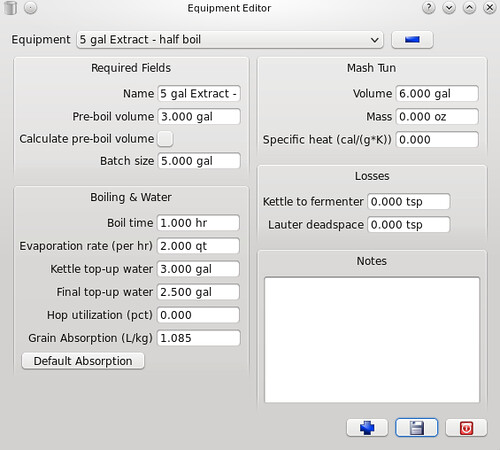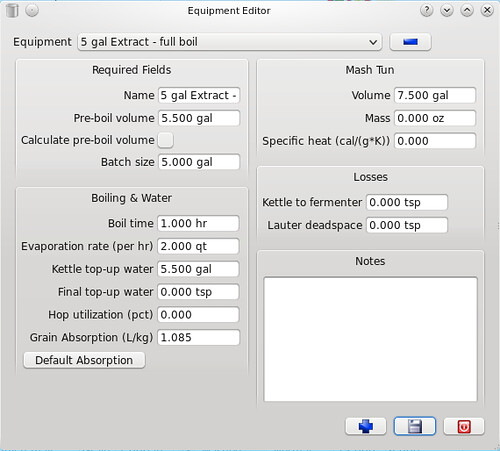Whatever quantity is in the "final top-up" water is how much you add after you're done boiling, or that you'll only boil for like 5 minutes, whether you add it in the fermenter or to the kettle. If you're doing just full boils, use the full boil equipment above. Also, be careful if the recipe calls for a half boil and you change it to do a full boil: you need to make sure the boil gravity is the same as the half-boil so that the IBUs are the same. The reason is that the boil gravity affects how much alpha acid is extracted from the hops.
No specific reason for the 6 gal in the mash tun.
Why does brewday mode always start of saying "you should have 0.000 tsp of wort". ?
Also, just so I can better follow with a partial boil.. take a look at this recipe given my 7.5 gallon kettle... how would you configure the equipment with what it says?
PROCEDURE:
Note: If you are using Wyeast liquid yeast, prepare the yeast 24 hours prior to brewing! Activate the yeast by “smacking” it to rupture the internal pouch, thereby mixing its contents with the other contents in the pouch. Allow the yeast to remain at room temperature to swell. Check the packaging date on the pouch. If it has been over two months since it was packaged, allow an extra day for the pouch to swell up. If you are using White Labs Pitchable Yeast, simply remove from refrigerator and allow to warm up to room temperature during the brew session.
1. In a small saucepan, bring a gallon of water to 160° - 170° and turn off the heat. Add the bag of grains and water salts (if used) and steep 30 minutes. Now, gently sparge (rinse) the grains with hot tap water (ideal temperature 168°) and bring the total volume up to two or more gallons in a stainless steel or enameled kettle (avoid aluminum). As a rule, boiling as much of the full five gallons as possible is best. Bring to boil and resume step #2.
2. Turn off heat and add malt extract. Return to boil, taking care not to allow wort to overflow onto your stove top. Start timing now, continuing the boil for 5 minutes. Add the bittering hops (1 oz. Warrior) and boil 45 minutes. Now add the flavoring hops (1 oz. Simcoe) and boil 10 minutes. For aroma, add the finishing hops (1/2 oz. Cascades) and immediately turn off heat.
3. To facilitate cooling, we suggest placing your brewing kettle in the sink with 5 or 6 inches of cold water (A tray or two of ice cubes in the cooling bath wouldn't hurt). Allow to stand for 20 - 30 minutes in the cooling bath.
4. For best results, we recommend using Wyeast or White Labs liquid yeast. If you are using dried yeast, we suggest you first rehydrate it while the wort is cooling. To do this, sprinkle the yeast into a cup of lukewarm (90° - 100°F) water and cover with saran wrap or tin foil. Let stand for 10 - 20 minutes.
5. Pour the cooled wort into the fermenter. Bring the total volume up to five gallons. Check and record the temperature and specific gravity at this time. Make the necessary gravity corrections for temperatures above 60° (Add.001 for every 7° above 60°F).
6. If the temperature is less than 80°, pour the yeast "slurry" and the packet of Bru-Vigor (if using tap water) into the wort and place the lid and airlock over the fermenter. Although ideal fermentation temperatures are lower,it is very important to get the fermentation started as soon as possible to avoid contamination of the beer. In any case, be aware that temperatures over 110° will most likely kill your beer yeast.
7. For best results, ferment at 60° - 75°F.































![Craft A Brew - Safale S-04 Dry Yeast - Fermentis - English Ale Dry Yeast - For English and American Ales and Hard Apple Ciders - Ingredients for Home Brewing - Beer Making Supplies - [1 Pack]](https://m.media-amazon.com/images/I/41fVGNh6JfL._SL500_.jpg)




























